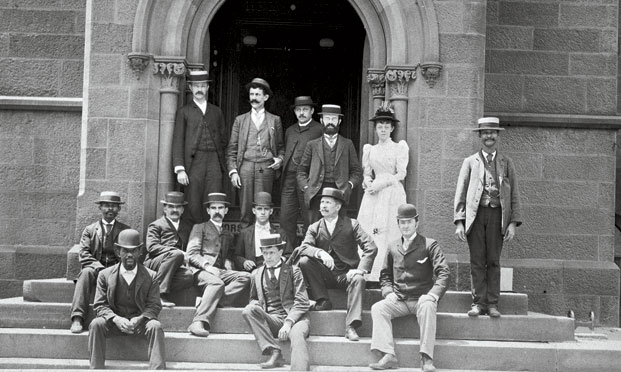Around Government
Culinary diplomats, space travel on per diem and battle of the buildings.
Dishin’ Out Soft Power
State Department chef serves up meals as part of the United States’ new culinary diplomatic corps.
Jason Larkin commands the kitchen of diplomacy. As the chef for the State Department, he’s in charge of preparing culinary concoctions for the many visiting diplomats and heads of state who pass through Foggy Bottom. This fall, he became part of the Diplomatic Culinary Partnership Initiative, a program that encourages cross-cultural exchanges through food.
Larkin joins an all-star lineup of gastronomic giants in the newly created American Chef Corps, a group that will travel to embassies around the world, preparing meals and promoting American cuisine and agriculture.
“I feel truly honored for the opportunity to work alongside so many chefs whose culinary talent I’ve admired throughout my career,” he says.
After starting his culinary career in the Washington area, Larkin did a stint at the world-famous Inn at Little Washington in rural Virginia. He began working for the State Department in 2005 as an assistant chef at the Blair House, preparing meals at the guest residence across the street from the White House.
Larkin is involved with every element of a diplomatic meal, from the menu to beverage pairings, to the table settings and décor. He taps the diversity of Washington’s culinary scene to personalize menus and to make foreign visitors feel at home.
“I like to give subtle nods to the visiting dignitary’s country by incorporating a familiar seasoning or ingredient,” Larkin says.
-Kedar Pavgi
Orbiting on Per Diem
The government gives federal travelers to Columbus, Ohio, $94 per day for lodging and $56 for food. Bound for Biloxi, Miss.? That’ll be $82 per day for shelter and $56 for grub. Go to the General Services Administration’s website and you can find a per diem rate for anywhere in the country (the State Department sets foreign per diem rates). But what if you’re going somewhere out of this world?
Astronauts receive a whopping $3.25 per day while in orbit, according to Nicole Cloutier, a NASA spokeswoman. That’s even less than the 1969 rate, apparently. Author Andrew Smith mentioned the expense policies of America’s space pioneers in his book Moondust: In Search of the Men Who Fell to Earth (Harper, 2005).
Apollo 11 astronauts Buzz Aldrin, Neil Armstrong and Michael Collins received an $8 per diem during their historic 1969 trip to the moon, according to Smith’s book. “When they went to the moon, they received the same per diem compensation as they would have for being away from base in Bakersfield: $8 a day, before deductions (like for accommodation, because the government was providing the bed in the spaceship).”
-Kellie Lunney
The Biggest Loser
Federal buildings compete to trim energy use.
From automatic light dimming when it is bright outside to waterless urinals, the architects behind the renovation of the Martin Luther King Jr. Federal Building in Atlanta have positioned it for gold.
That’s gold as in LEED Gold certified—a rating the U.S. Green Business Council gives to buildings with environmentally friendly designs—and gold as in winning the Environmental Protection Agency’s Battle of the Buildings. In its third year, the National Building Competition awards federal and private sector participants who show the biggest reduction in energy use over the previous year.
The renovation of the 1930s-era MLK building, formerly a post office and now headquarters for the General Services Administration’s Southeast Region, combined green technologies with historic preservation. “The sustainable rehabilitation project has helped save a substantial amount of energy and should figure significantly into the building’s showing in EPA’s competition,” says Tyrone Pelt, an electrical engineer with GSA.
More than 3,200 buildings, including nearly 600 federal properties, are competing in a variety of categories with the winners to be announced in April 2013. The competition is headed by EPA’s Energy Star program, which rates the energy efficiency of various projects.
In 2011, competitors cut their collective utility bill by more than $5 million.
-Eric Katz
Civil War and Civil Service
To commemorate the 150th anniversary of the Civil War, the Smithsonian is featuring “Experience Civil War Photography: From the Home Front to the Battlefront,” which showcases the agency’s role during the war. The exhibit, which will run through August 2013, includes this 1891 photo of staff members of the Bureau of International Exchanges, which facilitated exchanges of official publications with foreign countries. Solomon G. Brown (second from left), born a free man and self-educated, was the Smithsonian’s first African-American employee.

NEXT STORY: Triaging Audits



